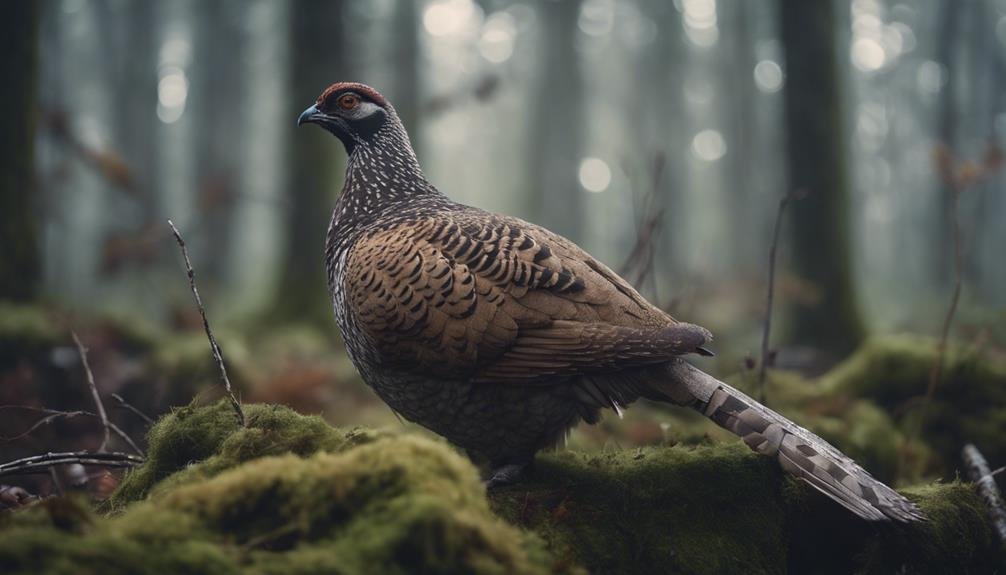In Minnesota's grouse hunting community, a cultural divide pits 'city slickers' against 'branch-blasters,' two groups with fundamentally different values and approaches to hunting. City slickers prioritize efficiency and precision, driving to Koochiching County with high-end gear and dogs, while branch-blasters embrace a more rugged, DIY approach, hunting without dogs and emphasizing rural pride. As societal values evolve, hunting ethics adapt, shifting from focusing solely on the kill to prioritizing fair chase, respect for the animal, and environmental stewardship. As you explore the complexities of grouse hunting, you'll uncover the nuances of this cultural war.
Key Takeaways
- The 'Grouse War' reflects a cultural divide between 'city slickers' and 'branch-blasters' with differing hunting styles and philosophies.
- Fair chase emphasizes respect for the animal and environment, prioritizing a moral compass and positive hunting image.
- Efficiency-oriented hunters prioritize filling the freezer, while fair chase hunters emphasize the thrill of the chase and respect for the animal.
- The fair chase philosophy promotes a strong moral compass, integrity, and environmental stewardship, ensuring a sustainable future for hunting.
- Hunting ethics have evolved to prioritize respect for wildlife, the environment, and the community, moving beyond just the kill.
Cultural Divisions in Grouse Hunting
In Minnesota's grouse hunting circles, a long-standing cultural divide exists between 'city slickers' and 'branch-blasters,' two groups that approach the sport with distinct styles and philosophies. The 'city slickers' drive to Koochiching County, armed with dogs and high-end gear, prioritizing efficiency and precision. In contrast, 'branch-blasters' hunt without dogs, wearing flannel shirts and embracing a more rugged, DIY approach. This cultural divide is rooted in regional traditions and hunting stereotypes. While 'city slickers' are often seen as outsiders, 'branch-blasters' are viewed as true locals. This tension reflects deeper debates about what it means to hunt grouse, and which approach is more authentic. As a result, Minnesota's grouse hunting community is marked by a rich cultural diversity, shaped by the state's unique regional traditions.
The Ethics of Fair Chase Hunting
Five centuries after firearms revolutionized hunting, the concept of fair chase continues to evolve, reflecting societal values and cultural norms that influence how we approach the pursuit of wild game. As hunting morals shift, so do our expectations of what constitutes fair chase. It's no longer just about the kill, but about respecting wildlife and the environment. Fair chase emphasizes the importance of hunting in a way that's respectful to the animal and the environment. This means considering the animal's welfare, respecting its habitat, and ensuring a clean, quick kill. By embracing fair chase, hunters can maintain a strong moral compass and promote a positive image of hunting. Ultimately, fair chase is about hunting with integrity, and that's essential for the future of our sport.
Perspectives on Pot-Hunting Methods
While fair chase principles emphasize the importance of respecting wildlife and the environment, pot-hunting methods prioritize efficiency and often spark debates about what constitutes ethical hunting practices. The debate surrounding pot-hunting methods is complex, with some arguing it's necessary for population control and others viewing it as unethical.
| Perspective | View on Pot-Hunting |
|---|---|
| Randy Newberg | Prioritizes efficiency in grouse hunting |
| Dan Dessecker | Recognizes cultural tensions between pot-hunters and wing-shooters |
| Jim Tantillo | Estimates his wing-to-pot-shooting ratio at 95% |
| Fair Chase Advocates | View pot-hunting as unethical and disrespectful to wildlife |
| Hunters with Harvest Limits | Prioritize efficiency to meet harvest limits |
Ultimately, the perspectives on pot-hunting methods highlight the need for ongoing discussions about what constitutes ethical hunting practices.
Gundog Owners and Hunting Styles
Among grouse hunters, gundog owners are a diverse bunch, with some training their dogs intensely and fixating on performance, while others value companionship and are more casual, just wanting a good dog. Gundog training can be a significant aspect of grouse hunting, with some owners investing countless hours into perfecting their dog's skills. However, others prioritize the bond between human and dog, seeing their gundog as a trusted hunting companion. These differing approaches often reflect the owner's personal hunting style, with some seeking efficiency and others valuing the experience. Regardless, gundog owners share a common passion for the thrill of the hunt, and the special connection formed with their canine companions.
The Art of Stalking Grouse
Stalking grouse requires a unique blend of stealth, patience, and marksmanship, as hunters must navigate dense underbrush and remain quiet enough to get within range of their elusive quarry. Understanding grouse behavior is vital, as these birds are masters of evasion, often freezing in place or flushing at the slightest disturbance. A hunter's instincts must be honed to detect subtle signs of grouse activity, such as rustling leaves or faint drumming sounds. As they stalk, hunters must remain acutely aware of their surroundings, using the terrain to their advantage while avoiding sudden movements that might spook their prey. By combining knowledge of grouse behavior with hunting instincts, stalkers can increase their chances of success in the challenging pursuit of these wily birds.
The Evolution of Hunting Ethics
As hunters adapt to changing environments and societal norms, their moral compasses have also shifted, reflecting a dynamic evolution of hunting ethics that spans centuries. Historic practices, once deemed acceptable, are now viewed as inhumane or unsustainable. Moral codes have evolved to prioritize fair chase, respect for the animal, and environmental stewardship.
| Era | Hunting Ethics |
|---|---|
| Ancient | Survival, subsistence hunting |
| Medieval | Nobility's hunting for sport |
| Industrial | Mass production, commercial hunting |
| Modern | Fair chase, conservation, sustainability |
Through this evolution, hunters have grappled with balancing their passion for the hunt with the need to respect the natural world. As societal values continue to shift, hunting ethics will likely continue to adapt, ensuring a sustainable and responsible relationship between humans and the environment.
City Slickers Vs Branch-Blasters
In the Minnesota grouse-hunting community, a long-standing cultural divide exists between 'city slickers' and 'branch-blasters,' two distinct groups with differing approaches to the hunt. City slickers, often from urban areas, drive to Koochiching County to hunt with expensive pointing dogs, donning game vests and shooting side-by-side 20-gauges. In contrast, branch-blasters, typically from rural areas, hunt without dogs, wearing flannel shirts and shooting long-tom 12-gauges at perched partridge. This cultural divide reflects differing priorities: efficiency versus fair chase. The city slickers prioritize efficiency, while branch-blasters emphasize Rural Pride and a connection to the land. This divide shapes grouse identity, with each group proudly maintaining their unique approach to the hunt.
Fair Chase in Modern Hunting
Fair chase, a concept emphasizing respect for the animal and environment, has evolved alongside firearms, with historical sporting artwork depicting hunters using nets to catch birds, suggesting that even then, hunters adhered to ethical codes. As hunting practices have changed, so too have the debates around fair chase. Today, modern traditions and hunting identities are shaped by these ethics.
| Hunting Style | Emphasis | Challenges |
|---|---|---|
| Wing-shooting | Sport, skill, and thrill | Marksmanship, dog work, and terrain navigation |
| Pot-hunting | Efficiency, meat, and subsistence | Stalking, concealment, and quick shots |
| Gundog hunting | Companionship, training, and community | Dog training, handlership, and teamwork |
In modern hunting, fair chase principles continue to influence hunting identities and traditions, shaping how hunters approach their craft.
The Role of Tradition in Hunting
Hunting traditions, whether rooted in cultural heritage or personal identity, continue to shape the way hunters approach their craft, influencing everything from gear choices to hunting styles. Rural traditions, passed down through generations, often define the hunting experience, with local customs and practices being deeply ingrained. For many, hunting heritage is an essential part of their identity, with family recipes, secret spots, and time-honored techniques being cherished and protected. These traditions not only connect hunters to their past but also to the natural world, fostering a sense of community and shared values. As a result, hunting traditions play a significant role in shaping the sport, informing decisions, and guiding practices that are both personal and collective.
Efficiency Vs Fair Chase Hunting
Roughly 500 years of firearms development have led to a cultural divide among grouse hunters, with some prioritizing efficiency and others emphasizing fair chase. This dichotomy reflects fundamentally different hunting philosophies, each with its own moral ambiguities. Those who prioritize efficiency often view hunting as a means to an end, where the goal is to fill the freezer. Conversely, proponents of fair chase hunting philosophy view the hunt as an end in itself, where the thrill of the chase and respect for the animal take center stage. This moral ambiguity raises questions about the ethics of hunting and the values that underpin our relationship with the natural world. As the debate rages on, one thing is clear: the way we choose to hunt says a lot about who we are as hunters and our place within the ecosystem.
Hunting's Cultural Significance
Beyond the debates over efficiency and fair chase, grouse hunting's cultural significance lies in its ability to shape identities, forge communities, and preserve traditions. In rural areas, grouse hunting is deeply ingrained in the local culture, influencing rural identity and community dynamics. Hunting traditions are passed down through generations, fostering a sense of belonging and connection to the land. The cultural divide between 'city slickers' and 'branch-blasters' in Minnesota highlights the diverse values and approaches within the grouse hunting community. Despite these differences, grouse hunting remains a powerful symbol of rural heritage, shaping local identities and preserving traditions that are deeply rooted in the American countryside.
Frequently Asked Questions
What's the Ideal Time of Day for Grouse Hunting?
Hunters often debate the ideal time for grouse hunting, with some swearing by morning strategies, when birds are most active, while others prefer sunset opportunities, when they're more likely to be perched and still.
Can I Use a .22 Rifle for Grouse Hunting?
Notably, 95% of grouse hunters prioritize wing-shooting over pot-hunting. When it comes to rifle selection, a .22 rifle can be effective for grouse hunting, but it raises ethical concerns, as it may not provide a quick kill, compromising fair chase principles.
How Do I Handle a Pointing Dog During a Hunt?
When handling a pointing dog during a hunt, facilitate dog communication and hunt discipline, using clear commands, subtle hand signals, and consistent body language to guarantee a successful and respectful grouse hunt, making certain that, to maintain
What Camouflage Pattern Is Best for Grouse Hunting?
Did you know that 70% of grouse hunters prioritize camouflage over other gear? For superior concealment, choose Mossy Outfits or Forest Shades, blending seamlessly with the surroundings to increase your chances of a successful grouse hunt.
Are There Legal Limits on Grouse Hunting Bag Sizes?
Hunters wonder, are there legal limits on grouse hunting bag sizes? Yes, regulatory changes aim to conserve grouse populations through conservation efforts, setting daily bag limits and seasonal restrictions to promote sustainable hunting practices.
Conclusion
As the grouse war rages on, hunters are forced to confront the mirror, echoing the words of St. Augustine, "The truth is like a lion; you don't have to defend it. Let it loose; it will defend itself." The pursuit of game is about more than just filling the pot; it's about the values we hold dear. Will we choose the path of fair chase, or succumb to foul play? The answer lies within, as we navigate the complexities of hunting with integrity, where the true test of character is not in the hunt, but in the hunter.









